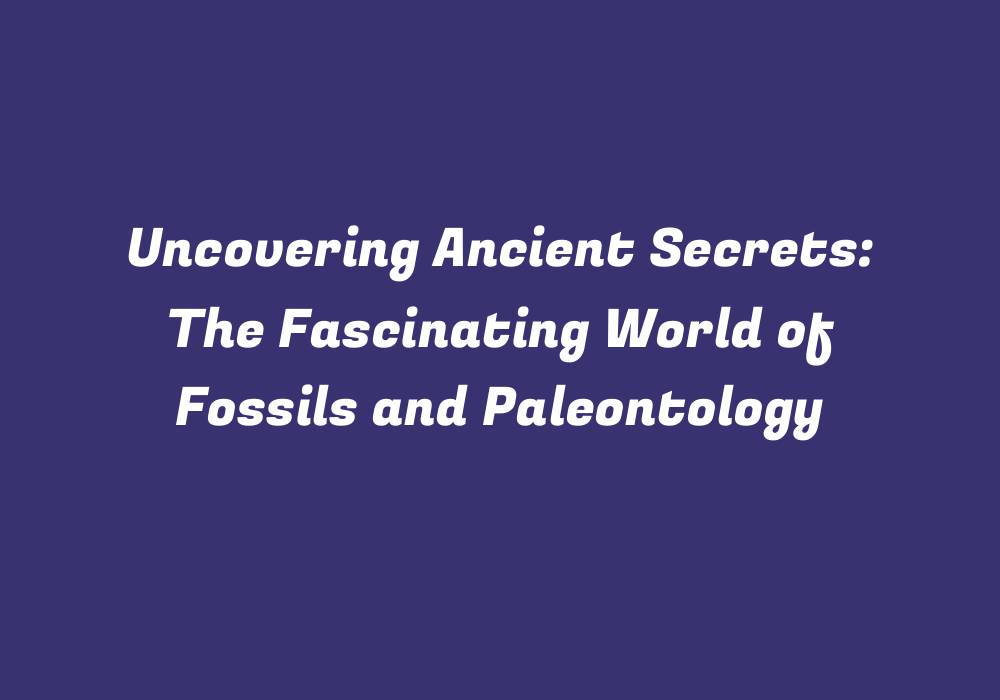Introduction: Unlocking the Past Through Fossils and Paleontology
Fossils have played a vital role in our understanding of history. They preserve records from past ecosystems, allowing us to uncover the secrets of ancient life forms. This fascinating world of fossils and paleontology is an ever-evolving field that continues to enlighten people about the complexities of evolution and our planet’s rich biodiversity.
Fossil Formation and Classification
Fossils are formed when an organism’s remains or impressions become preserved within sedimentary rock layers. They can take various forms, such as body fossils (organisms’ actual physical remains), trace fossils (evidence of behavior like footprints and burrows), microfossils (remains of small organisms, including single-celled lifeforms), and chemical fossils (signs of past biological activity).
Classifying fossils is critical for understanding the evolutionary relationships between extinct species. The Linnaean classification system, first introduced by Carl Linnaeus in 1735, organizes all living and extinct organisms into a hierarchical arrangement of taxonomic ranks (kingdom, phylum, class, order, family, genus, and species). This structure allows scientists to categorize fossils based on their evolutionary connections, making it easier to study past life forms.
Decoding Ancient History: Paleontology’s Role in Evolution Studies
Paleontologists are experts who specialize in the study of fossil remains and prehistoric life. Their work has been essential in piecing together a more accurate picture of our planet’s history, from its earliest beginnings to the evolutionary journey that culminated in complex modern ecosystems. Paleontology has played a vital role in shaping our understanding of macroevolution (large-scale changes in organisms’ characteristics over time) and microevolution (small-scale genetic changes within populations).
The field has also contributed to answering some of the most pressing questions about evolution, such as how species become extinct and how life adapts to changing environmental conditions. By studying fossils from different geological periods, paleontologists can assess the rates at which species evolve, their relationships to other organisms, and the factors that impact the development of new life forms.
Fossil Discoveries: Unveiling the Mysteries of Prehistoric Life
Over the centuries, numerous significant fossil discoveries have shed light on our understanding of ancient species and ecosystems. Some remarkable finds include:
1. Archaeopteryx – This bird-like creature, which lived around 150 million years ago, was once thought to be a missing link between dinosaurs and birds due to its combination of avian and reptilian characteristics.
2. Homo naledi – A recently discovered human ancestor found in South Africa’s Rising Star Cave System, Homo naledi lived approximately 2.5 million years ago and possesses a mix of primitive and advanced traits compared to other early hominid species.
3. Tyrannosaurus rex – One of the most recognizable dinosaurs in popular culture, the massive T. rex dominated Earth’s ecosystems during the late Cretaceous period, around 65 million years ago. Its discovery highlighted the diversity of dinosaur species and provided insights into their behavior and ecological roles.
4. Australopithecus sediba – A nearly complete skeleton unearthed in South Africa’s Malapa Fossil Site, Australopithecus sediba lived about 2 million years ago and has been heralded as a potential human ancestor with a mix of both hominid and ape-like features.
Fossils: A Tool for Studying Climate and Ecosystem Dynamics
Fossils also enable us to study past climate changes, understand the dynamics of ecosystems, and investigate how different life forms have adapted over time. Fossilized pollen and plant remains provide valuable clues about the types of vegetation that dominated particular environments and their geographic distribution. Similarly, studies on ancient animal communities can reveal information about food chains and interdependencies among various species.
By analyzing fossils in combination with other historical data such as ice core samples and sedimentary rock records, scientists gain a deeper understanding of Earth’s climate history and how it has impacted the evolution and extinction of various life forms throughout geological time. This knowledge can also inform predictions about future climate change scenarios and potential impacts on biodiversity.
Conclusion: Embracing the Fascinating World of Fossils and Paleontology
Fossils continue to reveal secrets about our planet’s rich history, providing critical insights into ancient life forms, evolutionary processes, and past ecosystems. The field of paleontology offers a unique lens through which we can explore the incredible diversity of life that has existed on Earth and gain an appreciation for the complexities of the natural world. As our understanding of fossils grows, so too does our ability to unravel the mysteries of our planet’s past and prepare for its ever-changing future.
